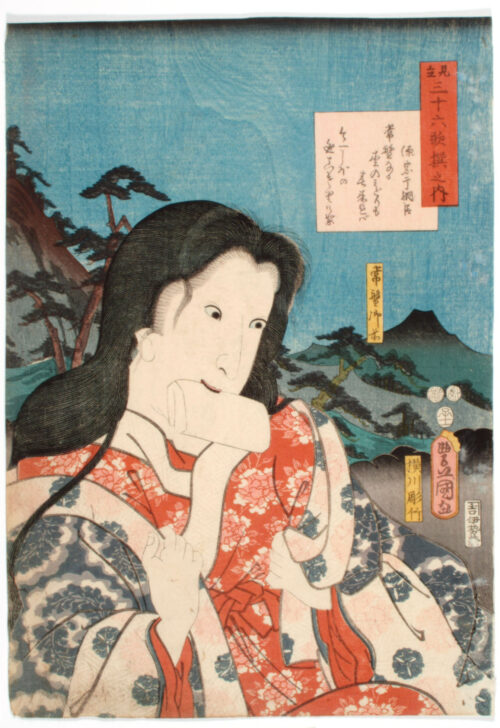Actors Compared with the Thirty-six Poet Immortals: Iwai Tojaku I as Tokiwa Gozen
Utagawa Kunisada

Description
In this series of prints, Toyokuni III (Kunisada) depicts popular kabuki actors against landscape backgrounds, and adds a cartouche with the name and a poem by one of the so-called "thirty-six poetic immortals," a selection of classical poets. The actors are identified only by the role and not by name, as actor prints had been forbidden in recent regulation. To a contemporary audience, of course, the actors would have been immediately recognizable by their physiognomies or actor's crests. Today, we can reconstruct the names of many, but not all, of the actors in the series.
In this scene, an unidentified actors is shown in the role of Lady Tokiwa (Tokiwa Gozen). Tokiwa was an historical figure of the twelfth century who came to symbolize the tragedy of the war between the Genji (Minamoto) and Heike (Taira) clans. As the concubine of Minamoto Yoshitomo, she bore him three children, the youngest of whom would grow up to be the famous warrior Yoshitsune. Tokiwa herself was forced to become the mistress of Taira Kiyomori, her deceased lover's enemy.
The entire series is illustrated online at http://62.238.34.70/toshidama/prints.stm
Subject Matter:
This print juxtaposes Tokiwa Gozen with a poem by Minamoto Muneyuki, a tenth century poet and statesman whose work appears in the Kokinshū, one of the classic poetry anthologies. Tokiwa Gozen appears in the play Kiichi Hogen’s Book of Tactics (Kiichibōgen sanryaku no maki).
The artist, Utagawa Toyokuni III, was notable for creating images of actors in which specific individuals were identifiable. Not only were these popular actors recognizably depicted for fan consumption through these prints, but they were associated both with the poet immortals and specific flowers, each of which had special meanings in Edo society. Such layered meanings are hallmarks of mitate (literally meaning look and compare) prints. Mitate images were usually indicated by the use of the word mitate in the title, though it sometimes was omitted and viewers were meant to puzzle it out. This genre often juxtaposed contemporary figures such as kabuki actors with historical figures such as the poet immortals. Edoites enjoyed these layered meanings and would have made the connection between this series and the poet immortals with relative ease.
Actor Iwai Tojaku I also held the names Iwai Kumesaburō I and Iwai Hanshirō V. He was born in 1776 and active from 1786 until shortly before his death in 1847. He was best known for his roles in contemporary plays and for his young onnagata (“female role” or “female form”) roles. He was also the father of the next two actors to hold the Hanshirō name. This print probably depicts one of his performances as Tokiwa Gozen.
Physical Description:
In this picture, a woman looks downward with a folded piece of paper in her mouth. Her hands are clasped around her elaborate outer robe. Her long hair flows down her back, with shorter strands around her face and shoulders. The scene behind her is of mountains and trees against a bright blue sky.
Inscriptions: Mitate sanjūrokkasen no uchi; Tokiwa Gozen; Mera & Watanabe (Censors' seal); ne 11 (Date); Toyokuni ga (Artist's signature); Yokogawa Horitake (Carver's seal); Kichi, Isekane (Publisher's seal)
Usage Rights:
If you are interested in using an image for a publication, please visit https://umma.umich.edu/request-image/ for more information and to fill out the online Image Rights and Reproductions Request Form.